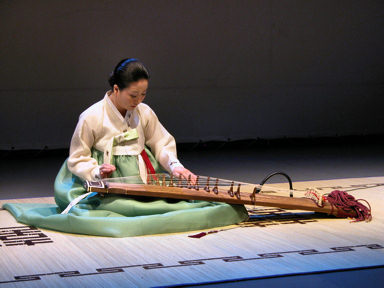'East
Meets West', Hee-Jo Kim, Beethoven, Tchaikovsky: Mi-Sun
Gwon (sanjo gayageum), Marialena Fernandes (piano), Thames
Philharmonia, Byung-Yun Yu (conductor) St John’s,
Smith Square, 11.03.2007 (JPr)

The
‘East meets West’ programme presented by Thames Philharmonia
did not venture too far East with the musical fare on
offer. Beethoven and Tchaikovsky are the epitome of ‘Western’
music so it was left to Mi-Sun Gwon (pictured here) and
her sanjo gayageum (Korean zither) to provide the Eastern
sounds.
Little information on the www is available about the gayageum
or kayageum (transliterated from kayagŭm) but it
is described is a 12-string half-tube plucked zither supported
by 12 movable bridges. An expert in Korean music, Dr Keith
Howard, describes it as follows ‘Strings run from pegs
beneath the top end of the instrument, over a low fixed
bridge curved to match the body, across individual movable
bridges made from hard wood, to looped cords. Reserve
string is held in coils behind each cord loop and the
cords themselves are anchored to the horns.’ There are
apparently two types of kayugŭm: popkum (‘law zither’)
and sanjo (‘scattered melodies’) kayagŭm. The sanjo
kayagŭm is the smaller one of the two (approx 142x23x10cm)
and is associated with folk music genres and may have
evolved in the nineteenth century with the emergence of
sanjo (improvisational solo instrumental music). It has
the soundboard of paulownia (‘princess tree’) wood and
has a harder wood such as chestnut for the sides and the
back.
The performer, Jocelyn Clark, suggests the closer spacing
of the strings and the shorter length of the sanjo kayagŭm
facilitates the technique required for the faster passages
of sanjo. The performer, sitting in a cross-legged position,
puts the head of the kayagŭm on his or her right
knee. He or she plucks and flicks the strings with the
index and middle fingers, and the thumb of the right hand,
and presses down the strings to the left of the movable
bridges with the left hand. No pick is used and the wide
vibrato and pitch-bending characteristics
of kayagŭm are achieved by pressing and pulling the
string with the bare fingers. The various pluckings, pressings
and pullings produce nonghyon (‘vibrating strings’),
the microtonal shading and subtle vibrato, and yo-um
(‘remaining sound’), the ‘after-tone’ that are deemed
the key aesthetics of Korean music. They make it sound
audibly different to ‘Western’ solo instruments and were
all clearly in evidence though Mi-Sun Gwon’s admirable
playing. However the rhythmic sound world of this fascinating
instrument took some getting used to in the conductor,
Byung-Yun Yu’s arrangement of Hee-Jo Kim’s short Concerto
in A minor pitted as it was against a typically ‘classical’
orchestral accompaniment.
Next in line to Mozart, Beethoven composed five piano
concertos and one violin concerto that redefined the relationship
that existed between the solo instrument and the accompanying
orchestra. They went a long way to differentiate them
clearly and allow the instrumentalist some sort of individual
expression. The soloist was from the East, Marialena Fernandes.
who was born in Mumbai but has made her second homeland
in Vienna where she has been a professor at the University
of Music since 2005. She uses this as a base for a career
performing both the music of the classical romantic period,
as well as embracing the contemporary and experimental.
With Ranko Markovic, Fernandes is involved in a cycle
of ‘Four Hands at One Piano’ events in association with
the Austrian Cultural Forum and the Mahler Society (review)
that will see them perform Mahler 7 later this year.
Fernandes eschewed throughout any over-weaning pomposity
and used a clarity and lyrical simplicity that was very
affecting and suited this most Mozartian of the five Beethoven
piano concertos. She has an impressive technique with
a warm tone, very strong left hand and excellent phrasing.
Her tight rhythmic control opened up and prolonged the
dialogue between the piano and the orchestra that was
supported by Byung-Yun Yu’s unfussy direction of his Thames
Philharmonia that he established in 1998. This was particularly
true with the strings and piano in the second movement
(apparently representing Orpheus taming the Furies at
the gates of Hades) and also when the solo cello underscores
the piano's initial statement of the opening theme from
the Finale. Fernandes’s keen ear for the orchestra and
the conductor’s for his soloist maintained an appropriate
balance that delivered Beethoven’s intentions especially
when distilled though Fernandes’s engaging personality.
After the interval there was a performance of Tchaikovsky’s
Symphony No.5 in E minor, Op.64. This was music composed
some eighty years after the Beethoven, during a period
of supposed happiness for the composer but as it is believed
to be a meditation on the way in which Fate seems to control
life, it may have a subtext in the composer’s closeted
homosexuality. His notebooks contained the following fragment
of a ‘programme’ for this symphony: ‘Introduction. Complete
resignation before Fate or, which is the same, before
the inscrutable predestination of Providence. Allegro.
(I) Murmurs, doubts, plains, reproaches against XXX .
. . (II) Shall I throw myself in the embrace of faith?’
The first movement begins sombrely. The opening theme
in E minor, played by two clarinets, becomes a recurring
motif for each of the subsequent movements, concluding
by beginning the Finale in a triumphant E Major.
It was the end of a long evening for the orchestra of
(as their website suggests) ‘keen amateurs’, string tone
began to suffer and the ensemble slackened just a touch.
However in the last two movements, and in the Finale,
particularly, there was some impressive orchestral playing.
Towards the end as the mood of the music swings from portentousness
to distinct optimism and picks up pace, Byung-Yun Yu drove
his musicians on full-throttle to quite a glorious finish
that thoroughly deserved the warm applause from another
tiny St. John’s, Smith Square, audience.
Jim Pritchard



